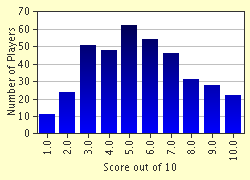Quiz Answer Key and Fun Facts
1. This ornamental plant from South America has spread all over the globe because of human actions. The dense mats of this plant choke out native vegetation and kill fish by reducing the dissolved oxygen content of the water. It has even been blamed for choking out human life in Papua New Guinea.
2. This amphibian was intentionally introduced into the vast sugarcane fields of Hawaii to control a beetle problem. Predators, in turn, began eating this poisonous animal, causing a decline in native predator populations. The animal is now considered a pest in Australia and on many Pacific and Carribean islands.
3. This mildly venomous snake, Boiga irregularis, was inadvertently introduced to Guam from the New Guinea area some time in the early 1950s. Since its introduction, it has wiped out at least 12 bird species endemic to Guam, some now extinct, and has been responsible for at least 1200 power outages.
4. This "vine that ate the South" was originally introduced into the southern United States as an ornamental but was later spread intentionally by government agencies to prevent soil erosion. It has been known to grow 60 feet in a single year and to damage forests by preventing trees from getting enough sunlight.
5. This omnivorous pest turtle, Trachemys scripta, has established populations in Japan, France, and Australia though it is native to North America. Its spread is due largely to its intentional exportation as food or as a pet.
6. A 1985 task force found that this predatory fish, introduced to Lake Victoria in 1959 by British anglers for sport, simultaneously threatened more vertebrate species with extinction (at least 150) than any other animal ever. While bringing prosperity to the fish industry surrounding Lake Victoria, the fish has brought ruin to the way of life of the native people.
7. The "grey blanket" over Australia refers to the spread of what animal that now causes over $300 million in agricultural damage to Australia every year?
8. This invertebrate that can kill large trees by tunneling into branches and trunks was discovered to be infesting hardwood trees in Brooklyn, New York in 1996 and in Chicago, Illinois in 1998. It is thought to have spread to the United States via solid wood packing material from China.
9. This pest insect was intentionally imported into the United States to start a silk enterprise. Its larvae eat oak leaves voraciously and can be easily identified by the blue spots on their first few segments and the red spots on the remaining segments.
10. This oddball Southeast Asian fish species' environmental impact in Florida is not yet well known. From 1968 to 1978, the fish spread itself from 3 counties in Florida to 20 counties.
Source: Author
ArtieChoke
This quiz was reviewed by FunTrivia editor
crisw before going online.
Any errors found in FunTrivia content are routinely corrected through our feedback system.


